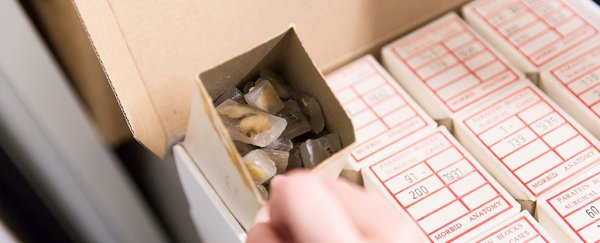A team of scientists are using the oldest intact tumours available to research the genes of rare childhood cancers. Their study is the first to sequence tumour samples that were collected nearly 100 years ago.
Currently, it is very difficult for scientists studying rare cancers to get their hands on fresh-frozen tumour samples, that is tissues preserved in liquid nitrogen shortly after extraction. These cancers are often so rare that only a handful of children around the world are affected at any given time.
"The treatment regimens for children with rare cancers are essentially made up," says senior researcher, Sam Behjati, from the Wellcome Trust Sanger Institute in the UK.
"If you've got three or four patients nationally, how are you ever going to conduct a reasonable clinical trial?"
This paucity of evidence makes sequencing and studying tumour samples from rare cancers extremely difficult, and it has led many researchers to look for samples from the past.
Until this study, the oldest tumour specimen sequenced was only 32 years old. But recent advances in massively parallel sequencing have allowed scientists to examine tumours that are much older.
To find the oldest intact tumour specimens available, Behjati and his team rummaged through the archives of the oldest children's hospital in the English-speaking world, London's Great Ormond Street Hospital for Children (GOSH).
It was there that they found and sequenced three childhood tumour samples that were collected nearly a century ago.
Normally, DNA that old would degenerate over time, but tissue preserved in formaldehyde can maintain DNA for nearly a century. This preserved tissue is highly conducive to DNA sequencing, and opens up a whole new bank of information for scientists wishing to study rare conditions.
Behjati and his team began the study by mining the archives of GOSH for tumours from the 1920s - a time when classification methods were most comparable to modern diagnoses.
The team picked three samples: a muscle cancer called rhabdomyosarcoma, a blood-vessel tumour called cellular capillary haemangioma and a lymphoma.
After confirming the original diagnoses using stained slices, the team extracted DNA from the remaining tissue and sequenced 366 genes in each one.
They found cancer-associated mutations in all three samples.
The research illustrates the bank of information that is available to scientists in these ancient archives, and the potential these tissues could have for studying rare conditions in the future.
The technique may be especially useful for studying rare childhood diseases. This is because the genomes of childhood cancers contain far less mutations than the genomes of adult cancers, making it much easier for researchers to identify specific mutations without all the interruptions from degraded DNA.
Behjati and his team plan to keep sifting through the GOSH collection, and may even begin to extend their search to other hospital archives. Their goal is to build up the sample size so they have a pool large enough to search for commonalities and potential drug targets.
Behjati hopes these past tumours will help researchers discover better options for future patients.
The study was published in The Lancet.
